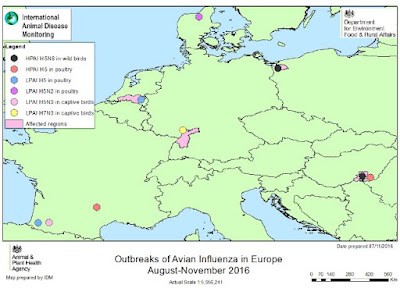#11,884
Although it was only 4 days ago when we saw the last update from the UK's DEFRA (Department for Environment, Food & Rural Affairs) on Avian Influenza in Europe, a lot has happened in the past couple of days with HPAI H5N8 outbreaks reported in Germany, Poland, and Austria.
While H5N8 hasn't yet proven to be a human health threat, it isn't lost on anyone that this is the same subtype that ravaged North America's poultry industry during the winter and spring of 2015, and has caused major losses in South Korea, China, and Taiwan over the past two years.
It has also become increasingly apparent that HPAI H5N8 is well suited for being spread by migratory birds (see FAO On HPAI H5's 4th Intercontinental Wave), and that other countries in the EU, Middle East, Asia, and even Africa may be at risk.
Today DEFRA has published an updated outbreak assessment. It should be noted that this was apparently drafted before the reports of H5N8 in Germany and Austria were confirmed.
Department for Environment, Food and Rural Affairs
Animal & Plant Health Agency
Veterinary & Science Policy Advice Team - International Disease Monitoring
Updated Outbreak Assessment Avian Influenza (H5N8) in Europe
8th November 2016 Ref: VITT/1200 Update 1: HPAI in Europe
Disease Report
The Hungarian authorities have confirmed an outbreak of HPAI H5N8 on a commercial turkey fattening farm in Bekes region. All 10,500 poultry have been culled by 3rd November. Three km protection and 10km surveillance zones have been established in line with Directive 2005/94/EC. The farm is in close proximity to wetlands and the HPAI H5N8 case was reported on the 26th October in a (wild) Mute Swan by a lake was nearby in Csongrad region, a well-known rest place for migratory birds at this time of year (see Defra, 2016). On 5th November, 74 wild birds were found dead at lake Dabie in the Goleniowski region of Poland and HPAI H5N8 was isolated from a pooled samples of 6 of them, consisting of five ducks and a seagull (European Commission, 2016). Controls under Council directive 2005/94 have been implemented.
Situation Assessment
The outbreak in Hungary and the wild bird cases in Poland are indicative of further evidence that this virus is circulating in wild birds and therefore incursions into poultry farms can be expected.
According to TRACES, the EU Electronic Trade Notification System, there has been no recent trade of live poultry, hatching eggs or day old chicks from the affected regions in Hungary or Poland to the UK. Meat and table eggs are lower risk commodities and provided they are not diverted from the human food chain do not represent a risk to poultry.
The Commission has alerted Member States to the increased risk at this time of year and the importance of these findings.
Conclusion
We would like to take the opportunity to highlight the “testing for exclusion” regime in GB. Where avian influenza (or Newcastle Disease) is not strongly suspected, a poultry keeper and their private veterinarian now have access to a testing service at the National Reference Laboratory, Weybridge. This will help detect a notifiable avian disease at the earliest opportunity for those cases. It is aimed at those cases where clinical signs cannot exclude NAD in a differential diagnosis and yet do not justify a consultation case or official inquiry. For more information, please see Gibbens et al. (2014) and www.defra.gov.uk/ahvla-en/disease-control/nad
At this stage, we consider that as there has been only limited trade with Hungary or Poland in live poultry (including hatching eggs) and none from the affected premises, there is a negligible risk of disease introduction into the UK via this route as a result of these specific outbreaks. Nevertheless we will continue to report on any updates to the situation and in particular any changes in disease distribution or wild bird movements which may increase the risk to the UK.
We would like to remind all poultry keepers to maintain high standards of biosecurity, remain vigilant and report any suspect clinical signs promptly. Poultry keepers should also remind themselves of the mild clinical signs of LPAI infection and be aware of any changes in egg production, feed and water intake or rise in mortality.
